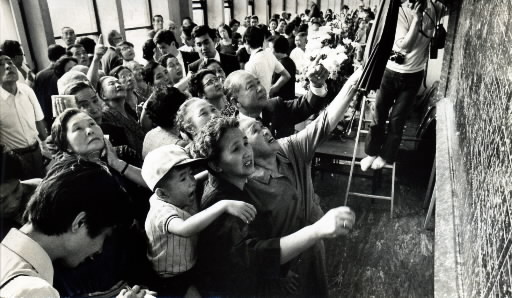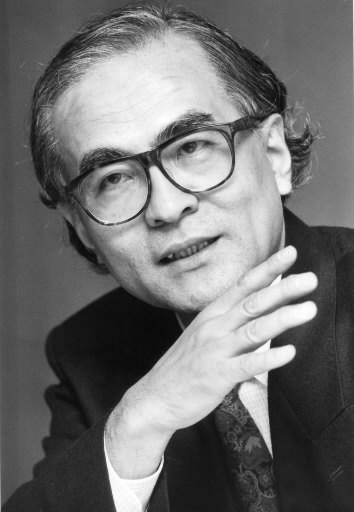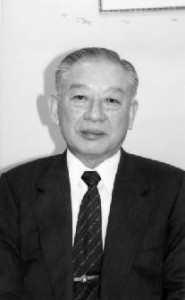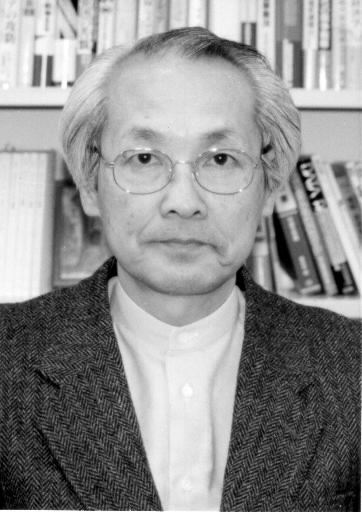History of Hiroshima: 1945-1995 (Part 16, Article 1)
Mar. 6, 2013
Campaign to “reconstruct” the hypocenter area
by Masuhei Ono, Senior Staff Writer
Note: This article was originally published in 1995.
Seeking to turn the devastating reality of the atomic bombing into a lasting memory of the human race, the A-bombed city of Hiroshima has made efforts to preserve and maintain A-bombed ruins, gather and archive bombing-related testimonies, records, and documents, and investigate the facts of the A-bomb damage. The city is now involved in a campaign to “reconstruct” the hypocenter, creating a map which attempts to “restore” a part of town that vanished in the blast and thereby shed light on the lives, deaths, and A-bomb experiences of those who once lived in this area. Along with this effort, preservation work on the Atomic Bomb Dome, which is building momentum for gaining a “World Heritage site” designation for the structure, is the embodiment of action undertaken by the city as a whole. Like many other efforts, the private sector has taken the lead over the public sector, and the progress made in these campaigns has largely been attributed to the work of private citizens. With regard to the campaign to “reconstruct” the hypocenter, the inspiration of a young director at the Hiroshima branch of Japan’s national broadcaster, NHK, and his station’s passion for the idea, played a large role in advancing the effort prior to the involvement of the City of Hiroshima and the Research Institute for Nuclear Medicine and Biology at Hiroshima University. Behind the preservation of the Atomic Bomb Dome was the “Hiroshima Paper Crane Club” and a tenacious man who served as the group’s leader for nearly 40 years. The Chugoku Shimbun now turns its attention to these Hiroshima campaigns which exemplify the preservation efforts of the city.
TV station creates map of hypocenter area before bombing
Tatsuhito Nagaya, then a fledgling director at NHK, Japan’s national broadcaster, was in a state of high emotion that morning, his mind occupied with worries and hopes. His 15-minute segment entitled “Camera Report: Radius of 500 Meters from the Hypocenter” was aired in the Chugoku region at 7:20 a.m. and he was anxious about the response. Though he usually arrived at his workplace at NHK’s Hiroshima Chuo Broadcasting Station, located in the Otemachi district, at around 10 a.m., he left the company dormitory in the Gion area earlier than usual and reached the station before 9:30.
It was the morning of August 3, 1966. Mr. Nagaya was met by a flurry of phone calls offering information about the life of the hypocenter area before the atomic bombing. He does not recall the number clearly, but he received at least 20 to 30 calls on that morning alone.
“At that point I felt the segment was a success,” Mr. Nagaya said. Now 55, and serving as an executive researcher at the NHK Broadcasting Culture Research Institute in Tokyo, Mr. Nagaya was nostalgic as he looked back on the unexpectedly strong response his program received.
This is how the campaign began to “reconstruct” the hypocenter area. The effort involved creating a map that would “restore” the appearance of the area within a radius of 500 meters from the hypocenter, gathering as much information as possible about the people who had resided there, and clarifying the full range of effects suffered by human beings as a result of the bombing. The campaign later became a large-scale investigation that lasted as long as eight years, having prompted the involvement of the city government and national government and expanding the scope of the project to a radius of two kilometers from the hypocenter.
Mr. Nagaya had just been transferred in the spring of that year from NHK headquarters in Tokyo, where he worked in the section dealing with politics and economics within the commentary division. He was a young staff member, with only four years under his belt at NHK. He had not worked on any documentary programs in Tokyo, and this was the second segment he was directing in Hiroshima.
He took up the challenge of creating the program when a general news editor at the station asked him: “Why don’t you do something about the atomic bombing?” It had only been a few years since the local Hiroshima broadcasters began to produce documentary programs on their own. Mr. Nagaya braced himself, believing it was a big opportunity. But he was from Gifu Prefecture and knew very little about the A-bombed city of Hiroshima.
Mr. Nagaya’s program came at a time when news coverage of the atomic bombing suffered from an excess of ideology, affected by a split in the movement against atomic and hydrogen bombs which took place three years before. “I was being impertinent, but I didn’t think it was right,” he explained. “The voices of the A-bomb survivors, the ones who experienced the atomic bombing, were not being conveyed. I mulled the situation and felt it shouldn’t be like that.”
The expression “family registers for ghosts,” which he read in a newspaper article, had made a strong impression, lingering in his mind since that moment. The phrase described the fact that, though some people had died in the atomic bombing, because their deaths could not be confirmed, their family registers still listed them as alive.
“What sort of civilized society, even 20 years after the atomic bombing, is unable to clarify the death toll and confirm these people to be either alive or dead?” Mr. Nagaya wondered. “Can’t we create a program that will address the things still unknown about the atomic bombing?” As he continued to gather materials for the program, his ideas flourished.
Pursuing such questions, Mr. Nagaya was struck by the notion: “Who were the people actually living in the vicinity of the Cenotaph for the A-bomb Victims in Hiroshima Peace Memorial Park? If we can shed light on that, the nature of the program will be symbolic.” When Mr. Nagaya began to focus not on the entire park, but exclusively on a ten-meter-square plot, with the cenotaph at its center, a concrete theme came to him in a flash.
Nakajima Honmachi, Zaimoku-cho, Tenjin-machi... Mr. Nagaya went looking for people who had lived in these vanished neighborhoods that were lying underneath the spot above the city where the atomic bomb exploded. Continuing his efforts to conduct interviews with former residents, he identified places and people in these areas, and a handwritten map spontaneously came into being.
The map held a curious power. It became a bridge which connected the dead and the living, A-bomb survivors and non-survivors. The act of noting down each house of their immediate neighbors stirred the memories of the former residents and produced a chain reaction of memories among them. Isolated threads of memory became woven together into a tapestry of that time. The map generated extraordinary excitement. “The program is complete,” thought Mr. Nagaya.
From his investigation, Mr. Nagaya deduced that the Yagawa paper box shop, the Watanabe sushi shop, a movie theater, and a cafe stood near the cenotaph, and he recorded the impressions of A-bomb survivors with regard to life at that time. Junzo Yagawa, 54, the eldest son of the Yagawa family and now a resident of Saeki Ward, Hiroshima, was able to survive the bombing because he and the shop had been relocated from the area prior to the attack. In a flash, he lost his parents and two sisters. Mr. Yagawa recounted those days for Mr. Nagaya.
Ryoga Suwa, 62, the chief priest of Johoji Temple, located just west of the cenotaph in downtown Hiroshima, also shared his story with Mr. Nagaya. Mr. Suwa, who had been evacuated from Hiroshima prior to the bombing, was orphaned when his parents and older sister were killed in the blast. Stories like this--full of sorrow and hidden from view--became the prevailing legacy of the vanished neighborhoods.
After the staff involved in the TV program had made the necessary preparations, the camera was ready to roll. They asked the former residents to gather in the main hall of Johoji Temple and, on a blackboard, a map of the area that lay within a radius of 500 meters from the hypocenter was created.
Before the camera, people’s memories were jogged more fully than in the interviews Mr. Nagaya had conducted with them prior to the filming. “What was located there?” “It was a diner, called Dongame. The woman who owned it was pretty.” Each person spoke nostalgically of that time, mourning deeply for the dead and offering words of comfort for their souls.
Mr. Nagaya’s segment was a success, shedding light on 130 households that once lived within the vicinity of the cenotaph. Even the head of the editing section, who had, while appreciating the intent of the project, coldly voiced his criticism, questioning whether such a program would be feasible to make, bowed his head and gave his congratulations.
August passed, but even through September and October, NHK received phone calls and letters from former residents of the hypocenter area. Mr. Nagaya insisted that additional installments of the program be made. Yutaka Tamura, 64, now residing in the city of Kawasaki, near Tokyo, took over as a section head in July, and he, too, strongly supported further coverage.
Mr. Tamura was a second-year student at Hiroshima Municipal Junior High School when he experienced the atomic bombing. His parents and younger brother, who lived in the Otemachi district, were seriously injured but managed to escape death. However, more than 100 friends of the same year from his school perished in the blast. Because of this personal experience, he had been all the more dissatisfied with news coverage of the bombing for some time, which he believed handled the atomic bombing merely as a matter of limited and transient interest and treated the survivors simply as interview material.
“A-bomb survivors only talk about their grief and pain and bitterness within the closed world of survivors,” explained Mr. Tamura, who was also a young man, just 35, at the time. “They lose hope right from the start, thinking that their experience can only be understood by others who were also exposed to the atomic bombing. That’s true for me, too. But this approach enables us to turn the survivors’ individual experiences into the experience of all citizens and society as a whole. I felt strongly that we could depict the entire A-bomb experience in this way.”
The enthusiasm of local NHK staff and the response from Hiroshima citizens reached the rest of the NHK network as well. In the summer of the following year, on August 4, 1967, a 30-minute program entitled “Footage Today and the Flash at the Edge of the Eaves: Neighborhoods at the Hypocenter are Restored,” an expanded version of Mr. Nagaya’s “Radius of 500 Meters from the Hypocenter,” was aired throughout Japan from Tokyo. The program instantly generated a nationwide response.
Meanwhile, the NHK station in Hiroshima formed a partnership with the Research Institute for Nuclear Medicine and Biology at Hiroshima University (whose director was then Kiyoshi Shimizu) to undertake more elaborate studies of the hypocenter area. The institute, on its own, also planned to conduct a survey to restore the life of the area prior to the bombing. A single TV segment had engaged an academic institution and become a strategic program for A-bomb news coverage.
“While I’m in Hiroshima, our A-bomb news coverage can focus exclusively on restoring the hypocenter area,” Mr. Tamura decided. The Hiroshima station then brought in Kantaro Kanazawa, now 59 and a professor at Hiroshima City University, to work with Mr. Nagaya, a year younger, and the NHK staff involved in news coverage of the bombing. The station also made the decision to create an official campaign out of its efforts to ‘restore’ the hypocenter area.
On March 20 of the following year, 1968, a preliminary survey of the Nakajima district, a part of the hypocenter area, was launched. With this survey, which was spearheaded by Minoru Yuzaki of the Research Institute for Nuclear Medicine and Biology at Hiroshima University, the Hiroshima TV station pursued its campaign in earnest. Making ample use of the morning program covering residents of Hiroshima Prefecture and the evening program providing general reports, the station conveyed information to the public that came from the citizenry. It also broadcast the news of important developments in this campaign.
Reflecting on that time, Mr. Kanazawa said: “Those were memorable days, when A-bomb news coverage was transformed from seasonal coverage, limited to August [when the atomic bombing took place], to daily coverage.” Surveys led to broadcasts, to responses, then to further surveys. The TV station, the public, and the academic community coordinated their efforts well, and NHK staff members dubbed this alliance “Trinity.” The campaign was pursued for roughly a year and yielded substantial results.
The City of Hiroshima appropriated funds in 1969, and the central government followed suit in 1970, to conduct an investigation into the damage caused by the atomic bombing, linking the survey efforts to “restore” the hypocenter with research clarifying the actual conditions of the A-bomb damage within a radius of two kilometers. At this point, NHK transferred the three main staff members engaged in the campaign to Tokyo, one after another, thus bringing the effort to an end.
Twenty-five years have passed since then and the three main figures of the campaign have gone on to perform other roles at NHK. Deep in their hearts, though, lie memories of their younger days and the A-bombed city of Hiroshima. When Mr. Tamura served as the chief director of programming, a question was raised about NHK’s annual broadcast of the Hiroshima Peace Memorial Ceremony on August 6: “How much longer will we broadcast the ceremony live?” Mr. Tamura responded, “We will do it forever,” conveying this intention in person to Tomokazu Sakamoto, then the president of NHK.
Mr. Tamura, who retired two years ago, said, “As someone who quickly fled Hiroshima after the atomic bombing, I had no choice but to seek the forgiveness of my departed friends through the work that I did.” Though Mr. Tamura was exposed to residual radiation when he entered the city in the wake of the bombing, he has not yet sought to obtain the Atomic Bomb Survivor’s Certificate. He explained awkwardly, his sentence left unfinished: “I feel guilty enough for having survived the blast. I can’t go so far as to acquire the certificate...”
Mr. Kanazawa later returned to Hiroshima to serve as a professor in the Faculty of International Studies at Hiroshima City University. “It feels like I came back to my second hometown after being away for a while,” he said.
Mr. Nagaya still holds the hope that the original vision of the campaign to “reconstruct” the hypocenter area can be realized via computer: “Collect information from each A-bomb survivor, in as much detail as possible, and preserve that data for future generations.”
Toward this end, a concrete plan has been formulated calling for the creation of an “electronic park” that will convey Hiroshima’s legacy. The idea seeks to integrate photos, drawings, testimonies, and artifacts of the atomic bombing via multimedia, preserving and reproducing them in electronic spaces.
“The Atomic Bomb Dome is preservation in form,” Mr. Nagaya said. “The electronic park is preservation in spirit. These two, complementing one another, will enable the A-bombed city of Hiroshima to be truly preserved and maintained. Though we didn’t have the means to do so back then, we do now. We can realize that vision now.” The passion for preservation that was lit 29 years ago is set to blaze brightly again.
(Originally published on May 7, 1995)











